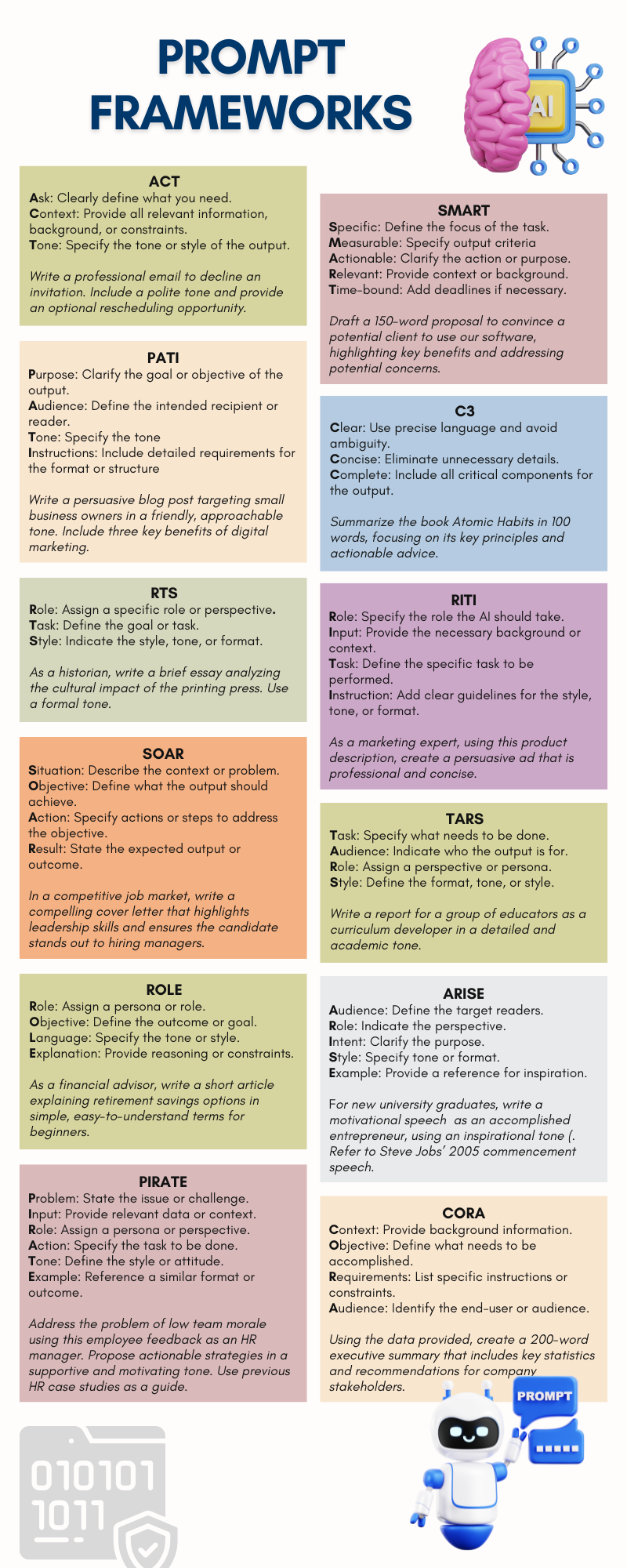Crafting Better Prompts with Prompting Frameworks
This post will introduce some prompting frameworks and how to use them effectively.
Many users dive into AI tools like ChatGPT expecting magic but quickly realize that getting specific results that are comprehensive isn’t automatic. For example, when I prompt ChatGPT with Tell me how to improve my marketing strategy, I got 8 points including: Understand Your Target Audience, Set Clear Goals, Refine Your Unique Value Proposition (UVP), etc. These strategies are appropriate for any marketing strategy. They are not unique to my situation. It requires finessing the prompt to get the result I want. This can take time and become frustrating. One approach is to use rompting frameworks, which offer a structured way to communicate with AI. Using these frameworks could transform how you use AI, saving you time and maximizing its potential.
This post will introduce some prompting frameworks and how to use them effectively. By the end, you'll be equipped to create prompts that get AI to deliver focused results.
The Anatomy of a Great Prompt
I searched for prompt frameworks and found more than 35 different frameworks. I quickly realized how overwhelming the options can be. How do you choose the best one? Are some frameworks better than others?
After diving in, I distilled a few essential components that make a prompt framework effective:
Context: Set the stage by defining the situation or purpose.
Role: Assign the AI a specific persona.
Task: Clearly state the desired outcome.
Constraints/Details: Add boundaries to refine the output.
Audience: Specify who the content is for.
Tone and Style: Define the voice or style of the response.
Most frameworks use a combination of these components. By focusing on these elements, you can create prompts that deliver tailored results.
Prompting Frameworks You Need to Know
Here are some frameworks that can help you.
P.A.R.A Framework
Purpose: What are you trying to achieve?
Audience: Who is the output for?
Role: AI’s persona
Action: Specific instructions
Purpose: To create a collaborative group activity for teaching students how to solve systems of linear equations using real-world scenarios.
Audience: Undergraduate students in an introductory linear algebra course who need hands-on practice with solving equations.
Role: Act as an educational activity designer for mathematics faculty.
Action: Design a step-by-step activity where students model a real-world problem (e.g., budgeting for multiple products) as a system of linear equations, solve it using different methods, and discuss the results.This is a simple approach that includes audience and tone.
S.T.E.A.P Framework
Situation: Provide context.
Task: What needs to be done.
Example: Offer an example for reference.
Action: Specify the desired response.
Parameters: Add constraints (tone, word count, etc.).
Situation: Students are learning about optimization in calculus and need to apply the concepts to solve real-world problems. The professor wants the activity to engage students by connecting the math to practical situations.
Task: Create a hands-on classroom activity where students solve an optimization problem, such as maximizing profit or minimizing cost in a business scenario. Include clear instructions and an example.
Example: Provide an example problem, such as finding the dimensions of a box with the largest volume that can be made from a fixed amount of material.
Action: Design a step-by-step activity that includes the problem, a solution outline, and discussion questions to help students connect the solution process with real-world applications.
Parameters: The problem should be solvable within a 30-minute class period, require minimal prior knowledge, and allow for group collaboration. Include a solution guide for the professor.In this framework, the audience is not overtly identified. The example component can work in two ways. ChatGPT can be prompted to provide examples, or we can upload examples that we would like ChatGPT to mimic. For example, when writing recommendation letters, providing examples will help ChatGPT frame the responses in your style.
C.R.E.A.T.E. Framework
Context: Set the stage.
Role: Define the AI’s role.
End Goal: Describe the desired result.
Audience: Specify the target audience.
Tone: Specify voice or emotion.
Examples: Share samples or references.
Context:The activity is for undergraduate students in an introductory statistics course. The goal is to help students understand probability distributions through interactive, hands-on learning.
Role:Act as an instructional designer who specializes in creating mathematics activities for higher education.
End Goal:Develop a classroom activity that uses real-world data to teach the concept of probability distributions (e.g., normal distribution, binomial distribution). The activity should include a problem for students to solve and guidance for the professor to facilitate discussion.
Audience:Students with a basic understanding of probability but no prior exposure to advanced statistics.
Tone:Practical, engaging, and easy to follow.
Examples:Provide one example of an activity using real-world data (e.g., sports statistics, weather patterns, or lottery numbers). Include instructions for students and a summary of the expected learning outcomes.Here again - similar to the STEAP framework, examples can be used in two ways. This is a comprehensive model that includes all the key components.
Chain of Thought Prompting
In this technique, ChatGPT is asked to use a step-by-step process of reasoning. It mimics how humans think through problems, making it particularly effective for complex tasks or those requiring detailed explanations. This ensures a transparent flow of logic. This makes it especially good for problem-solving or complex analytical tasks.
I’m learning Python and need to write a function that finds the second largest number in a list. Can you guide me through the steps to solve this problem, explaining the reasoning behind each step? Provide the code at the end.Just add Let’s think step-by-step to any prompt, and it will lead to a chain of thought prompt.
Below are other frameworks to consider.
Final Thoughts
By using structured approaches, prompting frameworks can simplify content creation, problem-solving, and learning. Every prompt you craft is an opportunity to work smarter and achieve more.
Found these frameworks helpful? Subscribe for more actionable insights on using AI effectively.
Got a favorite framework or challenge? Drop a comment and join the conversation!


